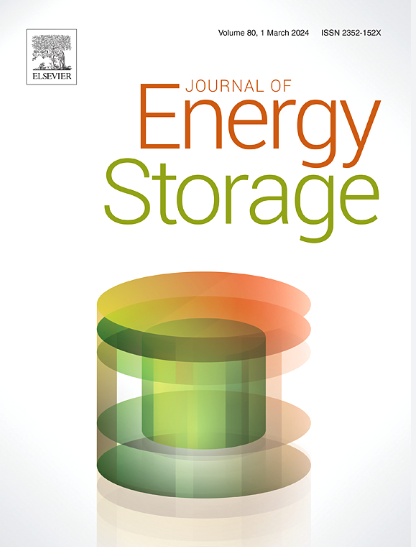Power-to-X过程中电池储能系统的设计框架
IF 8.9
2区 工程技术
Q1 ENERGY & FUELS
引用次数: 0
摘要
随着越来越多的工业过程依赖可再生能源输入来实现脱碳目标和满足严格的环境标准,能源储存变得越来越重要。存储系统对于缓解因可再生能源的不连续性而导致的工厂运行波动至关重要,允许可再生能源与过程的稳定性顺利协调。本文介绍了一个通用和系统的框架,作为一个自一致的分析工具,而不是传统优化技术的竞争性替代方案,以确定在Power-to-X过程中最大限度地减少电池储能系统容量的最佳交付策略。具体来说,我们提出了一个最优供电计划,将可再生能源任意波动的电力可用性转换为最优波动的电力输出。这样,所需的存储容量最小化,同时满足各种操作需求,如斜坡率和负载灵活性约束。该框架的主要新颖之处在于它的数值显式公式,它只需要很少的努力就可以实现,并且运行的计算时间很短,使其成为设计电池存储系统的方便快捷方法。最后,通过一个案例研究验证了框架的有效性,该案例研究涉及可再生能源工业设施的绿色制氢设计优化:准确地说,优化配置使氢气的平均成本为2.92美元/公斤,太阳能和风能的装机容量分别为50兆瓦和150兆瓦;电解槽容量69.88 MW;蓄电容量28.20兆瓦时(加州,2023年)。本文章由计算机程序翻译,如有差异,请以英文原文为准。

A framework for the design of battery energy storage systems in Power-to-X processes
Energy storage has become increasingly crucial as more industrial processes rely on renewable power inputs to achieve decarbonization targets and meet stringent environmental standards. Storage systems are essential for mitigating the fluctuations in plant operations that result from the discontinuity of renewables, allowing for a smooth reconciliation of renewable power with the steadiness of the process. This paper introduces a general and systematic framework, qualifying as a self-consistent analytical tool rather than a competitive alternative to traditional optimization techniques, to identify the optimal delivery policies minimizing the capacity of battery energy storage systems in Power-to-X processes. Specifically, we propose an optimal supply schedule that converts the arbitrarily fluctuating electric power availability from renewable sources into an optimally fluctuating electric power output. This way, the required storage capacity is minimized while concurrently meeting various operating requirements, such as ramping rates and load flexibility constraints. The main novelty of this framework lies in its numerically explicit formulation, which requires little effort to be implemented and a short computational time to be run, making it a handy shortcut method for designing battery storage systems. Finally, the framework's effectiveness is validated through a case study involving the design optimization of a renewable-powered industrial facility for green hydrogen production: precisely, the optimal configuration attains a levelized cost of hydrogen equal to 2.92 USD/kg, featuring solar and wind installed capacities of 50 MW and 150 MW, respectively; an electrolyzer capacity of 69.88 MW; and an electricity storage capacity of 28.20 MWh (California, 2023).
求助全文
通过发布文献求助,成功后即可免费获取论文全文。
去求助
来源期刊

Journal of energy storage
Energy-Renewable Energy, Sustainability and the Environment
CiteScore
11.80
自引率
24.50%
发文量
2262
审稿时长
69 days
期刊介绍:
Journal of energy storage focusses on all aspects of energy storage, in particular systems integration, electric grid integration, modelling and analysis, novel energy storage technologies, sizing and management strategies, business models for operation of storage systems and energy storage developments worldwide.
 求助内容:
求助内容: 应助结果提醒方式:
应助结果提醒方式:


